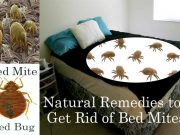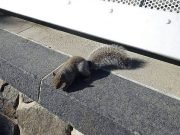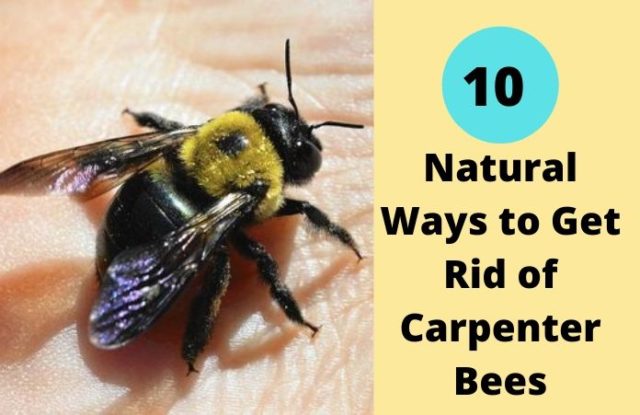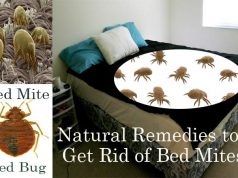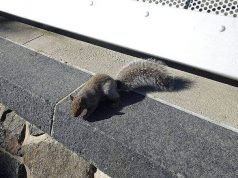Come spring and the buzz of Carpenter bees reaches a high crescendo in every North American backyard!
Carpenter bees along with Bumblebees are commonly found in North America. Though they are quite harmless to humans, they’ve known to create havoc on wooden structures.
Exasperated by the constant “ZZZZZ” of Carpenter bees? Looking for solutions to exterminate carpenter bees? Searching for a home remedy to control wood bees without killing them?
Read on for a complete guide on understanding the problem and effective home remedies to get rid of these seemingly innocent bees.
What is a Carpenter Bee?
The Carpenter Bee like the rest of the bee family belongs to the Hymenoptera order. They belong to the sub-family Xylocopinae. The smaller carpenter bees belong to the genus named Ceratina, while the larger carpenter bees fall under the genus Xylocopa.
Species of Carpenter Bees:
There are approximately thirty-five species of carpenter bees found in North America. There are about twenty-one different types of smaller Ceratina carpenter bees found in the United States and Canada. On the other hand, about seven species of the larger carpenter bees are commonly found in the US.
While the smaller carpenter bees are pretty harmless, the Xylocopa species of Carpenter bees are usually the ones that are guilty of causing damage to wooden structures.
Ever wondered why the carpenter bee is so-called?
The Carpenter bee derives its name from the Ancient Greek word for “woodcutter”.
Did you know that the Carpenter bees do not eat wood? Then why do we call them Carpenter Bees?
It is their ability to chew through both soft and hardwood that has earned them their peculiar name.
The Female Carpenter bees build their nests by boring into wood, tunneling through the wood, and creating a hole or cavity in it. No wonder they are also known as Wood bees.
What do Carpenter Bees look like?
Carpenter bees are about ½ inch to one inch long. Some smaller carpenter bees may be as small as ¼ inch. Most carpenter bees are mostly hairless and have a metallic underbelly.
Their colors range from different shades of blue and black like metallic blue, violet-blue, and even greenish-black. One of the most commonly found Carpenter Bee is the Peacock Carpenter bee which has a bright blue-green metallic color.
A carpenter bee is often mistaken as the Bumblebee. The best way to differentiate the two similarly sized bees is by focusing on the hair. While a Carpenter Bee is mostly hairless and has a metallic underbelly, the Bumble Bee is fully covered with hair.
What attracts the Carpenter Bee?
Wondering what attracts that swarm of carpenter bees to your backyard?
Carpenter bees like all other bees simply love flowers. Flowers provide these buzzing insects with their first love – nectar and pollen.
Female Carpenter Bees are always on the lookout for old and used nests. So if you have any old nests at home, they are sure to attract more Carpenter Bees to your backyard.
Untreated wood is another attraction to Carpenter bees. Stacks of firewood, untreated wooden patios, wooden decks, fences, and doors are sure to bring them to your home.
Most Carpenter Bees are attracted to raw and unfinished wood, and weathered, rotting, decaying, and deadwood. Carpenter bees are more attracted to softwood trees as compared to hardwood trees. Some of their favorite wood includes trees like pine, cedar, cypress, fir, oak, eucalyptus and redwood to name a few.
Signs of Carpenter bee infestation:
Here are some clues that indicate the presence of Carpenter Bees in your home:
- Entrance holes in the wood
- Sawdust, pollen and bee excreta near the entrance hole
- A loud sound of female bees tunneling through the wood.
- Male Carpenter Bees flying around and their characteristic loud buzzing sound.
Are Carpenter bees dangerous?
If you are worried about your little one being stung by Carpenter bees in your backyard, you may rest assured.
Contrary to popular belief, Carpenter bees are not dangerous to humans. Though Male carpenter bees look intimidating, they are not capable of stinging. However, in rare circumstances, the usually passive female Carpenter Bees may sting humans if provoked.
Damage done by Carpenter Bees:
Carpenter bees seem pretty harmless in the short run. However, in the long run, Carpenter Bees may cause substantial damage to wooden structures.
Repeated Carpenter bee tunneling activities lead to extensive damage. It speeds up the process of decay, rotting, and humidity. This leads to structural damages, leakage, and aesthetic damage.
10 Natural ways to get rid of Carpenter bees:
There are several natural ways to get rid of carpenter bees. These home remedies will help control the onslaught of Carpenter bees without burning a hole in your pocket.
Citrus scents:
Carpenter Bees strongly dislike robust citric scents. All you need to do is to simply create a citric scent spray by boiling the juice of citrus fruits like oranges, grapefruit, lemons, and lime along with water. Fill it in a spray bottle and sprinkle this home remedy to keep bees away.
These citrus scents will stop bees from attacking your property without killing them. Plus, a sweet-smelling patio will be an added bonus.
You may even use fruit peel or rind for temporary relief from Carpenter bees.
Vacuum:
You may also use a wet vacuum to suck out Carpenter Bees from their holes. Take the tiniest nozzle of your vacuum and hover near the Carpenter bee infested area. The high power suction of your vacuum will suck out the bees in a jiffy.
For optimum results, use the vacuum in the evening time when the den is filled with the bees. Also, make sure that you use a really high power vacuum so that you are able to suck the bees with success.
Wooden Bee Trap:
If you are looking to control the Carpenter Bee without spending much time and energy, then its time for you to invest in the Carpenter Bee or Wooden Bee Traps that are easily available in most stores.
Ideally, these traps should be placed next to wooden surfaces that have prior Carpenter Bee drilling holes in them. Wooden traps are also a great way to prevent wooden bee infestation from happening.
If you are looking to trap other insects like wasps, and bumblebees, you may use a bait made of soda and liquid soap.
Non-toxic Trap Stick:
Another efficient trap that is commonly found in the market is the non-toxic trap stick. This trap stick made from paper and cardboard attracts the Carpenter Bee with its bright and dazzling colors. The bees that are attracted to it get trapped on its strong adhesive and are trapped there forever.
Paint:
Carpenter bees love to invade on weathered and decaying wood. Regular maintenance goes a long way in keeping these bees away. Apply a coat of paint or varnish to your wooden products to prevent them from decaying. Always remember to apply paint on the often neglected underside for optimum results.
Oil-based paints or latex paints are strong deterrents to Carpenter Bees.
Essential Oils:
Essential oils like citronella oil, tea tree oil, lavender oil, and jojoba oil are the perfect natural Carpenter Bee repellant to control Carpenter Bees. Fill a spray bottle with this natural home remedy and sprinkle it on wooden surfaces.
Carpenters bees detest almond oil and almond essence. These can be used as natural Carpenter Bee repellants.
You may even apply eucalyptus oil on areas infested by Carpenter bees to prevent them from future infestation.
Noise:
So many times we are worried about hovering bees when we have a backyard barbecue party at home. A perfect and instant solution is to make some loud noise.
Carpenter Bees are peace and quiet loving creatures. They simply hate loud noises and intense vibrations. If you can bear with a loud noise for some time, creating an earsplitting noise is a hassle free and easy Carpenter Bee repellent that keeps the bees away for the time being. Make sure you don’t disturb your neighbor while you play your favorite music on full blast.
Plug the Holes:
One of the best ways to keep female Carpenter Bees from returning to your homes is by filling in old Carpenter Bee nests. While applying paint is an efficient solution against Carpenter Bees, always remember to fill nail holes, old nests, and cracks with putty or caulk to prevent Carpenter Bees in the long run.
The best time to plugging holes is during spring when the bee activity is high or during summer when new adults are arising.
Swatting
Who doesn’t enjoy the childish fun of using a tennis or squash racquet to swat away at pesky pests? Carpenter Bee activity is exceptionally high during the spring period. Have a racquet handy, smack away at the troublesome bees to keep them from bothering you.
Boric Acid
The combination of Boric acid mixed with water is a strong potion to exterminate Carpenter Bees. This magical potion consists of 3 parts of water and 1 part of boric acid. Apply this deadly concoction to wooden structures frequented by bees. This toxic blend also works wonders to annihilate bee larvae from growing.
Carpenter Bees are an important part of our ecosystem as they aid in the pollination process. Prevention of Carpenter Bees is always better than cure!





















